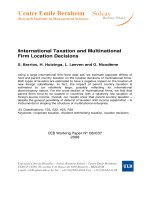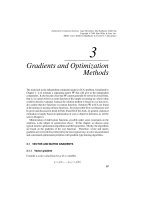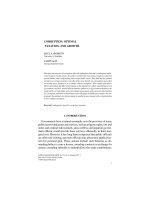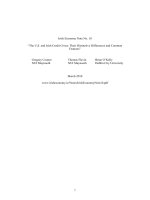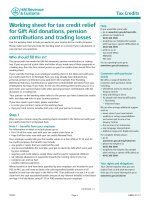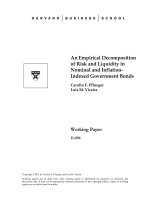Taxation and Government Intervention ppt
Bạn đang xem bản rút gọn của tài liệu. Xem và tải ngay bản đầy đủ của tài liệu tại đây (263 KB, 53 trang )
© 2003 McGraw-Hill Ryerson Limited.
Taxation and Government
Taxation and Government
Intervention
Intervention
Chapter 7
Chapter 7
© 2003 McGraw-Hill Ryerson Limited.
7 - 2
Laugher Curve
Laugher Curve
Two economists meet on the street.
Q. How’s your wife?
A. Relative to what?
© 2003 McGraw-Hill Ryerson Limited.
7 - 3
Taxation and Government
Taxation and Government
Government needs tax revenues to
function.
© 2003 McGraw-Hill Ryerson Limited.
7 - 4
How Much Should
How Much Should
Government Tax?
Government Tax?
In order to answer how much
government should tax, we must know
the costs and benefits of taxation.
The benefits result from the roles of
government.
© 2003 McGraw-Hill Ryerson Limited.
7 - 5
How Much Should
How Much Should
Government Tax?
Government Tax?
From previous chapters we know that
government’s roles include:
Providing a stable set of institutions and
rules.
Promoting effective and workable
competition.
Correcting for externalities.
© 2003 McGraw-Hill Ryerson Limited.
7 - 6
How Much Should
How Much Should
Government Tax?
Government Tax?
From previous chapters we know that
government’s roles include:
Creating an environment that fosters
economic stability and growth.
Providing public goods.
Adjusting for undesirable market results.
© 2003 McGraw-Hill Ryerson Limited.
7 - 7
The Costs of Taxation
The Costs of Taxation
The costs of taxation include:
The direct cost of the revenue paid to
government
The loss of consumer and producer surplus
caused by the tax
The administrative costs of collecting the
tax.
© 2003 McGraw-Hill Ryerson Limited.
7 - 8
The Costs of Taxation
The Costs of Taxation
When government raises taxes, there is
a loss of consumer and producer
surplus that is not gained by
government.
This is known as deadweight loss.
© 2003 McGraw-Hill Ryerson Limited.
7 - 9
The Costs of Taxation
The Costs of Taxation
Graphically the deadweight loss is
shown on a supply-demand curve as
the welfare loss triangle.
The welfare loss triangle – a geometric
representation of the welfare loss in
terms of misallocated resources caused
by a deviation from a supply-demand
equilibrium.
© 2003 McGraw-Hill Ryerson Limited.
7 - 10
The Costs of Taxation
The Costs of Taxation
Fig. 7-2, p 162
Fig. 7-2, p 162
S
1
= S
0
+t
P
1
–t
Quantity
Price
P
0
Q
0
P
1
Q
1
Producer
surplus
S
0
Demand
Consumer
surplus
Deadweight
loss
tax
A
F
C
E
B
D
© 2003 McGraw-Hill Ryerson Limited.
7 - 11
The Costs of Taxation
The Costs of Taxation
There are additional costs of taxation.
Resources must be allocated by
government to collect the tax and by
individuals to comply with it.
© 2003 McGraw-Hill Ryerson Limited.
7 - 12
The Benefits of Taxation
The Benefits of Taxation
The benefits of taxation are the goods
and services that government provides.
© 2003 McGraw-Hill Ryerson Limited.
7 - 13
The Benefits of Taxation
The Benefits of Taxation
Some of these benefits are the part of
the basic institutional structure of a
market economy that allows it to
function efficiently.
The basic legal system is an example.
© 2003 McGraw-Hill Ryerson Limited.
7 - 14
The Benefits of Taxation
The Benefits of Taxation
Other goods have the qualities of a
public good – fire and police services
are examples.
© 2003 McGraw-Hill Ryerson Limited.
7 - 15
The Benefits of Taxation
The Benefits of Taxation
Some benefits are provided for reasons
of equity or because they provide
positive externalities. For example,
education and healthcare.
© 2003 McGraw-Hill Ryerson Limited.
7 - 16
The Benefits of Taxation
The Benefits of Taxation
Measuring the benefits of these goods
is difficult since they are often provided
at a zero price.
© 2003 McGraw-Hill Ryerson Limited.
7 - 17
Two Principles of Taxation
Two Principles of Taxation
Government follows two general
principles when deciding about taxation
The benefit principle and
The ability-to-pay principle
© 2003 McGraw-Hill Ryerson Limited.
7 - 18
Two Principles of Taxation
Two Principles of Taxation
The benefit principle states that the
individuals who receive the benefit of
the good or service should pay the cost
(opportunity cost) of the resources used
to produce the good.
Examples are gasoline taxes and airport
taxes, both paid by travelers.
© 2003 McGraw-Hill Ryerson Limited.
7 - 19
Two Principles of Taxation
Two Principles of Taxation
The ability-to-pay principle states that
individuals who are most able to bear
the burden of the tax should pay the
tax.
The best example of this is a progressive
tax, such as the Canadian income tax.
© 2003 McGraw-Hill Ryerson Limited.
7 - 20
Difficulty of Applying the
Difficulty of Applying the
Principles of Taxation
Principles of Taxation
The principles of taxation are difficult to
apply.
The two principles often conflict.
© 2003 McGraw-Hill Ryerson Limited.
7 - 21
Difficulty of Applying the
Difficulty of Applying the
Principles of Taxation
Principles of Taxation
The elasticity concept helps provide
insight into the taxation debates.
The more broadly the good or service is
defined, the more inelastic its demand.
© 2003 McGraw-Hill Ryerson Limited.
7 - 22
Difficulty of Applying the
Difficulty of Applying the
Principles of Taxation
Principles of Taxation
Governments should tax inelastic goods
or services – those are captured by
broad based taxes such as income and
sales tax.
© 2003 McGraw-Hill Ryerson Limited.
7 - 23
Difficulty in Applying the
Difficulty in Applying the
Principles of Taxation
Principles of Taxation
In the language of consumer and
producer surplus, if the government
seeks to minimize the welfare loss, it
should tax goods with inelastic supplies
and demands.
© 2003 McGraw-Hill Ryerson Limited.
7 - 24
Who Bears the Burden of a
Who Bears the Burden of a
Tax?
Tax?
The person who physically pays the tax
is not necessarily the person who bears
the burden of the tax.
The burden of the tax depends on
relative elasticity.
© 2003 McGraw-Hill Ryerson Limited.
7 - 25
Burden Depends on Relative
Burden Depends on Relative
Elasticity
Elasticity
The tax burden is greater if a person
cannot easily change their behaviour.
The more inelastic one’s relative supply
and demand, the larger the tax burden
one will bear.
